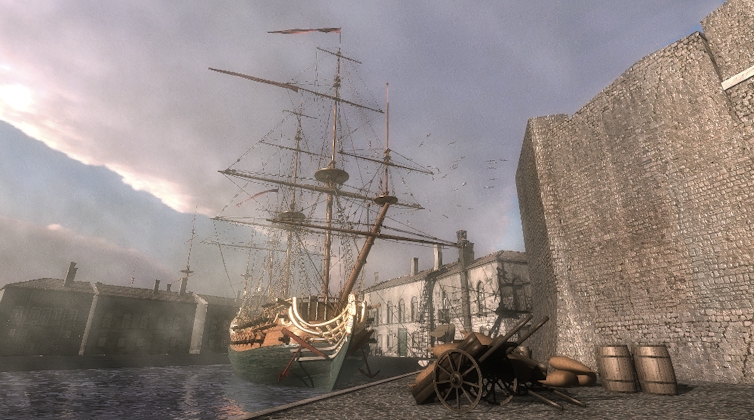It’s almost impossible, 400 years later, to imagine the scene in September 1620, when groups of English Puritans took their last look at the land of their birth while descending a few damp, slippery steps in Sutton Pool (today, the Barbican), Plymouth. How they felt while being ferried out to the Mayflower, a cramped, creaking square-rigged merchant ship, moored outside the harbour – and what they thought of the vessel, with its basic facilities and cargo.
But after four centuries, thanks to virtual and augmented reality technologies, for the first time we are able to see what that departure might have been like.
The Virtual Mayflower project has been one of the most challenging we have ever undertaken, seeking credible, historical research and deciding how we can use interactive technologies for a broad range of end users of different ages and backgrounds.
The project took us from a beached wreck near Hastings to the Mayflower II replica in the US. Meetings ranged from demonstrations at the US ambassador’s London residence to visualisation trials on Plymouth Hoe and from the council chambers in Droitwich Spa to Canary Wharf in London’s Docklands. The Virtual Mayflower story spans six years of ambition, elation, disappointment and – ultimately – a respectable degree of success.
We have been involved with numerous Plymouth maritime heritage projects since 2005 – mainly undersea wrecks – exploiting VR to “render the invisible visible”, as we did in the 1990s with projects such as Virtual Stonehenge. The Virtual Mayflower effort was kickstarted 250 miles to the east of Plymouth, on Pett Level Beach near Hastings. The Anne, a warship built for King Charles II’s Royal Navy, was launched in 1678. She was deliberately beached and torched at Pett Level in 1690, during the Battle of Beachy Head, to prevent capture by the French.
There she remained until the storms of 2013 exposed her lower structures. Collaborating with the Hastings Shipwreck Museum, we developed a detailed and explorable VR model of the ship and undertook a world-first demonstration using AR techniques, visualising the ship from above through the cameras of a drone – in effect looking down through the Anne’s masts as she rested in situ on Pett Level’s sands.

Realising a vision
Our success in exploiting VR and AR techniques during the Anne project brought numerous requests to become involved in the 400th anniversary commemorations of the Mayflower’s sailing. The first major development for us was an invitation to visit the Mayflower II in Plymouth, Massachusetts (at that time being prepared for transit to Mystic Seaport in Connecticut for her major refit) and Plimoth Plantation, the original location of the Pilgrims’ first home in the New World.
We were able to use 360-degree spherical panoramic cameras to capture many areas of the ship (including views from the crow’s nest) and were also shown the impressive costume repository held by the plantation. This was to be invaluable during the later reconstruction of the virtual pilgrims and ship’s crew. Also presented was the Mayflower II’s “shallop” – a replica of a small boat that was, in 1620, shipped across the Atlantic in four pieces, reassembled to ferry the early reconnaissance teams to Cape Cod’s peninsula (known today as Provincetown Harbor), and later used to land the Pilgrims at Plymouth Rock.
The data collected from the visit, plus a range of 3D assets available online, enabled us to recreate a VR scene featuring both the Mayflower and the smaller unseaworthy Speedwell (ultimately abandoned in Sutton Pool). We then set about developing more detailed versions of the ship and harbour. One of the biggest challenges we faced was how best to represent the passengers and crew of the Mayflower, and the Sutton Pool inhabitants.
In 2017 we acquired a new piece of wearable motion capture (MOCAP) hardware. The Perception Neuron was a flexible “exoskeleton” comprising small Inertial Measurement Units, data from which were transferred to a backpack-worn laptop. We undertook a unique trial of this technology on board one of the Jubilee Sailing Trust’s tall ships, the Lord Nelson, moored at London’s Canary Wharf. Despite appalling weather, the ship’s bosun’s mate, Beth Goss, climbed 34m of the vessel’s main mast, her every movement recorded by the suit and two 360-degree cameras.
But in the final evaluation, we decided that neither this, nor a more conventional optical MOCAP technique, provided us with sufficiently reliable, noise-free human movement data for use with virtual humans (“avatars”). So we approached game designer, Mike Acosta, from Royal Leamington Spa College, to develop the virtual passenger, crew and Sutton Pool inhabitants – with appropriate period clothing – for the VR scenarios.
As well as conducting research into how best to represent the humans of the time, including one of the more important of Pilgrim leaders, Edward Winslow (only one painting of whom exists, in the Pilgrim Museum in Plymouth Massachusetts), we also sourced many historic documents and maps, each providing different views of the Sutton Harbour area.

These, as well as information from books and images by numerous authors and illustrators, enabled us to develop a detailed 3D model of the Sutton Pool area, complete with lighting, mist and other environmental effects. Users can now don VR headsets and explore the harbour before descending the original location of the Mayflower Steps. There, they will get into a small boat that will ferry them out to board the small ship that was to be home to 102 Pilgrims for 66 days in the most abominable of circumstances.
Visitors to our project website can read about the Virtual Mayflower story in detail. The hope is that our reconstruction of such an important historical event, emphasising not only the “here today, gone tomorrow” nature of the Mayflower’s visit to Plymouth, but the rich history surrounding that small, remote west country harbour, will provide a legacy contribution to the 400th anniversary commemorations and an inspiration to future generations of creative media students.

